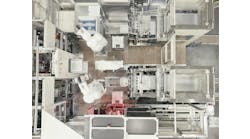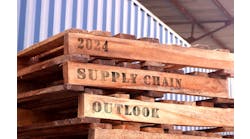Clean-label and smart laminates are rapidly becoming consumer favorites, attributed to rising demand for information transparency. Packaging plays an indispensable role across all business verticals. The industry has moved far beyond the traditional box or carton-based delivery of goods toward a well-calibrated ecosystem incorporating storage, supply and presentation of commodities in a cost-efficient manner. In addition to cost-efficiency, brands are also focusing on delivering a superior consumer experience.
The introduction of packaging laminates is a notable trend in this respect. Burgeoning demand for sustainable, clean-label and flexible packaging solutions across a range of industries has provided substantial ground for the packaging laminates market to flourish. Laminates help to provide insulation and strength besides enhancing the appearance of a product.
Packaging laminates are widely used across the food-and-beverage industry, as well as healthcare, pharmaceuticals, cosmetics and personal-care domains, among other industries. Significant developments regarding lamination technology and product innovations have contributed to the market’s success in the past few years.
Here are some of the leading trends that are expected to shape the future of packaging lamination.
1. Brands will increase investment in personalized packaging
As brands focus on creating a strong recall value, there is a growing emphasis on customized packaging solutions. This personalized packaging approach has proven to be a beacon for future expansion as it helps end users to identify with a brand’s product.
A case in point is Anheuser-Busch’s theme-based packaging. The Busch and Busch Light beer cans largely appeal to outdoor activity enthusiasts, especially fishermen and hunters. The company also organizes a “hunt” for a gold can, which can win an individual gear and a company-sponsored hunting trip.
Coca-Cola initiated its personalized packaging campaign titled “Share a Coke” where customers would scan supermarkets and department stores to find a friend’s name or their own printed on bottles. The campaign allowed the beverage giant to engage directly with its customers across 32 countries.
While Coke printed thousands of common names to increase its brand presence, the perception among consumers that the company was reaching out to them on a personal basis increased their confidence within the brand. This helped its sales to spike dramatically.
The project combined conventional printing with the digital Printing to generate 800 million high-quality personalized labels. Also, in 2018, Frito-Lay, announced that it would provide 10,000 personally customized bags of its Lay’s potato chips with photographs of consumers’ favorite summer moments.
Personalized packaging also incorporates a sundry brand’s story of evolution. Assertive companies realize that people relate to stories in equal proportion to the brand name. Description of the brand’s history in a story format helps to garner a wider customer base. Thus, brand personalization is an emerging trend and is sure to perpetuate in the future.
Although the advantages of personalized packaging aren’t lost on the brands, the associated high production costs remain a deterrent.
2. Say hello to cybernetic and smart printing
Perhaps the most prominent technological advancement with respect to packaging laminates is the incorporation of digital printing. Digital printing has made it immensely easy for companies to package and personalize products. This trend has been building itself up over several years and has acquired immense popularity of late.
There is no homogeneous digital packaging solution, thus providing creative space for designing customized packaging solutions. A number of flexible packaging solutions providers are effectively leveraging digital printing platforms to make their product outreach stronger across major countries.
Finland’s Huhtamaki Global is one of the pioneers when it comes to digital printing solutions. With limitless thinking as its cornerstone, the flexible packaging company offers unlimited design freedom for brands to deliver a personalized and unique engagement with end users, employing the digital press for its packaging designs.
The company’s emphasis on innovative and smart digital printing enables a realm of new packaging possibilities. These have translated into variable data printing, quick turnaround times, short runs and energizing shelf appeal of flexible pouches and laminates.
From biscuit or chocolate packets to large point-of-sale banners, digital printing has carved out an essential role in ensuring product promotions and safety through flexible packaging, shrink sleeves and labels. These are typically available in pre-made pouches or roll forms and offer various benefits over conventional printing technologies.
The use of technology in packaging has created new possibilities. For instance, narrow web digital printing presses overtook standard flexo presses for the very first time in 2018. The technology permits multiple colors to be printed on a single pass, fostering the printing on-demand trend.
3. Sustainability, transparency and clean label
Consumers increasingly demand adequate information about the products they purchase, especially when it comes to pharmaceuticals, food stuff and other perishable commodities. Hence, manufacturers are compelled to present product information in a clear and transparent manner.
Digitalization has enabled consumers to avail information at their fingertips. This implies that they also demand what kind of packaging material is employed to deliver the said product. If the material used is unsafe or undesirable, consumers tend to drift toward those platforms that offer safer alternatives.
In order to reduce customer churn, producers are exploring various sustainable and clean-label options, as well as providing details about the packaging techniques deployed. For instance, in September 2020, Nuvae Healthcare and Constantia Flexibles collaborated to launch a recyclable version of the EcoLamPlus laminate packaging solution.
EcoLamPlus is one of Constantia Flexibles’ renowned products in the monopolymer EcoLam packaging family based on polyethylene (PE) materials. The solution is highly effective to sustain volatile products such as alcohol. This renders it to be a highly flexible mechanism that is completely recyclable.
The clean-label tag has also pervaded the food-and-beverage sector. Today, more U.S. consumers scan food packages with their smartphones to ascertain the ingredient composition. Realizing this, leading packaging laminate companies have introduced the concept of smart labels.
The label code within it immediately connects customers to a page that provides transparent information about how clean the choice may be. This demand for transparency is anticipated to pervade the packaging industry throughout 2020 and beyond, presenting credible opportunities for market players to introduce new solutions.
4. E-commerce as the new normal
Projections indicate the e-commerce industry to nearly double in the next three years, attributed to increasing access to the Internet and smart devices.
Consequently, specialized packaging specifically for online retailing are being explored by vendors. When it comes to virtual retailing, Amazon pivots the entire market. The company has heavily invested in automating its processes, including digital printing and physical packaging.
Since August 1, 2019, vendors marketing their products through Amazon are required to meet the company’s packaging guidelines, known as Frustration Free Packaging. These guidelines apply to products exceeding the 18x14x8-inch dimensions or 20 lb. These specifications offer enhanced protection, are easy to open and incorporate 100% recyclable material.
The outbreak of the COVID-19 pandemic has provided further stimulus to the e-commerce industry, with customers shifting their budgets toward consumption of hygiene products and ready-to-eat foodstuff. While demand across the non-essential segment has suffered, the essential-commodities category has witnessed steady growth.
In spite of several logistical difficulties, ranging from limited air and land freight transportation to the sealing of international borders, e-commerce giants have discovered approaches to circumvent these barriers. Additionally, curbs on essential goods and services have lifted, making it possible to deliver pharmaceutical and food products, heightening demand for safe packaging solutions.
5. Less-is-more sentiment
Minimalist product packaging designs are steadily gaining acceptance. This trend is endemic to the modern food packaging industry. Minimalist packaging is desired due to its simplicity. Contemporary consumers desire economy and simplicity, which is why paper and paperboard packaging is so important.
This also holds true with regard to information dissemination. Any retail chain which overloads its packaging with copious amounts of details instantly loses its customer base. Labels offer fine print, but excessive product details may discourage consumers from purchasing that particular product.
The trend of minimalist packaging pervades all levels, ranging from artisanal boutiques to superstores. From Peter Saville’s Tate Modern pale ale and Tate Design Studio, Mandarin Natural Chocolate Bars by Yuta Takahashi to the SOTO Bottle by Joe Doucet, all have greatly helped simplify packaging and save costs.
The future roadmap
As is evident, the global packaging and associated industries have witnessed substantial growth in the past, and will continue exhibiting this trend in the coming future. Most of this growth is being stimulated across emerging economies and developing markets, attributed to surging disposable incomes and heightening e-commerce penetration.
The global population is expected to reach almost 10 billion by 2050. Most of this growth is slated to be exponential, concentrated mostly in India and China. This is leading to widespread urbanization, leading to an improvement in the standard of living.
Consequently, access to knowledge regarding efficient packaging is bound to increase, heightening demand for packaging laminates. Also, increasing life expectancy will augment demand for healthcare products, which require advanced packaging techniques.
Internationalization of several fast-moving consumer goods continues to rise, as companies seek out new high-growth sectors and markets. These manufacturers are seeking to establish robust distribution frameworks, including off-line and online sales channels in order to make their products available to their customers.
It remains to be seen how industrial domains are able to effectively exploit robust packaging solutions and incur substantial cost savings, as a significant proportion of businesses are yet to scale up their operations.
Ismail Sutaria is senior consultant, packaging, at Future Market Insights.




